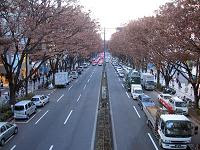 What's a splendid way to spend a beautiful autumn day in Tokyo? The gorgeous Keyaki tree boulevard of Omotesando, often called the Japanese Champs-Elysees, attracts many nostalgic foreigners. "Omotesando" means "front approach"
What's a splendid way to spend a beautiful autumn day in Tokyo? The gorgeous Keyaki tree boulevard of Omotesando, often called the Japanese Champs-Elysees, attracts many nostalgic foreigners. "Omotesando" means "front approach"Known on the name of Tokyo's Champs-Elysees, Omotesando is a one kilometer long, tree lined avenue, serving as the main approach to Meiji Shrine. Numerous stores, boutiques, cafes and restaurants, including several leading fashion brand shops, stand along the avenue. This avenue conects Jr Harajuku and Aoyama. There always are stream of people in various ages.
It is subway station and neighbourhood in Tokyo stretching from Harajuku station to Aoyama-dori where Omotesando station can be found. Zelkova trees line both sides of the avenue. Around one hundred thousand cars drive down the main street daily which serves as the main approach to Mejii Shrine.
Omotesando is an area of symbolic buildings, popular shops, wide sidewalks and trees, where many people come to take a leisurely walk It is known for its rapidly changing mixture of young culture and residential space.
Surely considered one of the top three most popular areas of town in Tokyo, the streets of Omotesando and Aoyama with their fashionable shops, lovely open-terrace cafes and hip beauty salons are as full of creative vigor and energy as ever. A number of fashionable beauty salons are hidden in the back streets. Give one a try, if you have time, or make a reservation to visit one you like.
Strolling along the main streets, you will have the chance to take in all the splendor of this fabulous shopping district, yet veering off to a back alley, you will encounter the surprisingly familiar daily activities of local residents.
In Omotesando and its adjacent Aoyama, fashion designers began to set up their offices and studios after the Tokyo Olympics in 1964. Since then, more and more fashion stores for adults and fashionable coffee shops and restaurants have been built in this area. Aoyama with its zelkova tree lined avenue has the atmosphere that resemble those in European streets.
It is known as an upscale shopping area featuring several international brand outlets, ranging from Louis Vuitton, Gucci etc to the more affordable The Body Shop, Zara, and others, that’s why it is so called "Tokyo's Champs-Élysées".
It has opened the largest Louis Vuitton shop in Japan in 2003, and queues are frequent. It is one of the rare avenue of the Japanese capital to be planted with trees all its length.
Beginning with Louis Vuitton Omotesando, which just opened this September, and the Esquisse Omotesando building complex, which offers all the luxury brand names like Chanel and Gucci, Omotesando offers you dozens of different brand name shops of all descriptions-fashion, cosmetics, interior design, you name it. After walking and walking, take a load off and rest your sore feet at any of the lovely street cafes.
Omotesando is also home to the famous Japanese toy store Kiddyland and the latest development, Omotesando Hills, which opened in 2006. Side-streets leading off Omotesando feature a range of trendy cafes, bars and restaurants, as well as boutique stores specialising in everything from handbags to postcards to vintage glass bottles.
Japan's first posh western-style apartment buildings, the classic Dojunkai apartment buildings along the avenue, match the atmosphere perfectly. Unfortunately, these buildings are soon to be torn down, rebuilt and modernized. From Omotesando straight down to Kotto-Dori (Curio Street), you can enjoy high-end window-shopping to your heart's content.
This neighborhood, where creative minds gather, has many museums and unique galleries to satisfy your artistic interests. Nezu Museum, behind Kotto-Dori Street, is a treasure house of Oriental classic art with a magnificent garden. In the tearoom, you can enjoy ceremonial ground green tea and Japanese confections. If you prefer more radical, modern art, why not visit the Okamoto Taro Memorial Museum next door?
Omotesando is filled with joy during any season of the year, but it is at its most beautiful in late autumn, when the leaves of the tree-lined Omotesando Boulevard and the ginkgo groves at Jingu Outer Shrine turn bright yellow. This is a must-see for a most impressive urbane day of leisure.
Best Information about Harajuku.
No comments:
Post a Comment